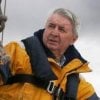Ireland is on course to become the first country in the world to complete seabed mapping.
The mapping of the seabed off the Burren and the Cliffs of Moher on the Clare coast will be one of the keynote topics at Geopark Academy 2024, a two-day conference organised by the Burren and Cliffs of Moher UNESCO Global Geopark as part of European Geoparks Network Week to be held on Saturday, May 25 and Sunday, May 26.
Limestone rocks were formed in shallow, warm, tropical seas there, 10 degrees South of the Equator, 330 million years ago.
Geological Survey Ireland (GSI) will provide an update on its groundbreaking seabed mapping project at the event, which will be held at the Burren College of Art in Ballyvaughan. This year, the college is marking its 30th anniversary of foundation.
Felim O’Toole, a Hydrographic Surveyor with GSI, will be one of the keynote speakers and will update on the Integrated Mapping for the Sustainable Development of Ireland’s Marine Resource (INFOMAR) project, which has been mapping Ireland’s coastal seabed in comprehensive detail. The INFOMAR programme team, which includes the Marine Institute, aims to complete Ireland’s seabed mapping by the end of 2026, when it could be the first country globally to do so. Mr. O’Toole’s talk will focus on mapping the seabed off the Burren and Cliffs of Moher.
Dr. Eamon Doyle, a Geologist with the UNESCO Global Geopark, who will open the conference, says the Burren holds many “fascinating clues to conditions on Earth more than 300 million years ago. The oldest rocks visible on the Burren’s surface were formed during the Carboniferous period, approximately 330 million years ago. These limestone rocks formed in shallow, warm, tropical seas. Scientists come from all over the world to see what we have here.”































































